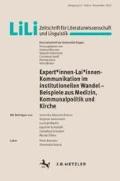Zusammenfassung
Der Beitrag untersucht den Novellenschatz von Heyse und Kurz mit Verfahren der quantitativen Textanalyse, um Aspekte des Novellenbegriffs der Herausgeber zu rekonstruieren. Ausgangspunkt ist die Diskussion der Frage, ob der Novellenschatz als eine repräsentative Sammlung von Novellen des 19. Jahrhunderts angesehen werden kann, ob also Aussagen über den Novellenschatz zugleich auch belastbare Aussagen über die Novelle im 19. Jahrhundert sind. Im Anschluss werden die Ergebnisse dreier Untersuchungen vorgestellt. Zuerst wird ein Verfahren vorgestellt, mit dem man unter bestimmten Bedingungen stilistische Vorbilder in einer Textsammlung ermitteln kann. Die Anwendung auf den Novellenschatz ergibt überraschenderweise Eichendorff als das wichtigste ›Modell‹ der Texte. Außerdem wird über eine vergleichende Analyse der Figurenkonstellation in den Novellen und in Romanen aus dem 19. Jahrhundert plausibel gemacht, dass Heyses Metapher von der starken Silhouette tatsächlich ein Differenzkriterium bezeichnet. Die dritte Untersuchung kann plausibel machen, dass die Herausgeber des Novellenschatzes überwiegend solche Novellen von Frauen ausgewählt haben, die eine weibliche Hauptfigur haben, während sie im Fall von männlichen Autoren Hauptfiguren beiderlei Geschlechts zugelassen haben.
Abstract
When the writers Paul Heyse and Hermann Kurz edited the collection of narrative texts published under the name Novellenschatz (treasure of novellas), in selecting the texts and writing the quite instructive introductions to the texts and the collection they were led by a notion of what a novella is. This essay analyses some aspects of this concept of novella. Starting with the discussion, whether the collection is representative for the German novellas of the 19th Century, three approaches are presented. First a method is presented which allows to determine models for authors in a collection spanning some time. Applying this method to the Novellenschatz yields the rather surprising result, that the romantic writer Eichendorff is the most influential writer of the corpus. Secondly, a definition of the novellas as having a clear-cut silhouette in comparison to the novel is tested using the character interactions modeled as a graph as proxy. The result shows that there really is a difference between the genres, at least the novellas in the collection and a collection of contemporary novels. Thirdly, using PCA on the hundred most frequent words it can be shown that one of the components is clearly different for the text by female authors in the collection, a closer analysis reveals that the texts by female authors have been selected based on the gender of the protagonist, while the selection of texts by male authors wasn’t restricted by gender politics.








Notes
Die Analyse wurde durchgeführt mit der Implementierung von Delta durch unsere Würzburger Arbeitsgruppe; vgl. https://github.com/fotisj/pydelta. Ein Jupyter Notebook, das den Code und die Resultate der hier durchgeführten Untersuchungen enthält, findet sich unter https://github.com/fotisj/novellenschatz.
Die Idee zu diesem Experiment stammt von Isabella Reger, die auch die Werte berechnet und die Grafik erstellt hat.
Der Unterschied zwischen den PCA-Werten für die zweite Hauptkomponente bei den Texten mit einer weiblichen Hauptfigur zu den Werten der Texte mit einer männlichen Hauptfigur ist bei Anwendung des t‑Tests hochsignifikant.
Die Analyse mit pyzeta wurde mit Christof Schöchs Implementierung durchgeführt, vgl. https://github.com/cligs/pyzeta.
Literatur
Burrows, John: »Delta: a measure of stylistic difference and a guide to likely authorship«. In: Literary and Linguistic Computing 17(3) (2002), S. 267–287.
Burrows, John: »All the Way Through: Testing for Authorship in Different Frequency Strata«. In: Literary and Linguistic Computing 22,1 (2007), S. 27–47.
Degering, Thomas: Kurze Geschichte der Novelle. München 1994.
Evert, Stefan/ Jannidis, Fotis/ Proisl, Thomas/ Reger, Isabella/Vitt, Thorsten/ Schöch, Christof/ Pielström, Steffen: »Outliers or Key Profiles? Understanding Distance Measures for Authorship Attribution«. DH conference, Krakow 2016.
Freeman, Linton: »Centrality in Social Networks. Conceptual Clarification«. In: Social Networks 1 (1978/79), S. 215–239.
Hempfer, Klaus W.: »Zum begrifflichen Status der Gattungsbegriffe: Von ›Klassen‹ zu ›Familienähnlichkeiten‹ und ›Prototypen‹«. In: Zeitschrift für französische Sprache und Literatur 120 (2010), S. 1–32.
Heydebrand, Renate v./Winko, Simone: Einführung in die Wertung von Literatur. Paderborn 1996.
Heyse, Paul: »Einleitung«. In: Thomas Weitin: Volldigitalisiertes Korpus. Der Deutsche Novellenschatz. Hrsg. von Hermann Kurz und Paul Heyse. 24 Bände. 1871–1876. Darmstadt/ Konstanz 2016 (noch unveröffentlicht).
Jannidis, Fotis: »Netzwerke«. In: F.J./Hubertus Kohle/Malte Rehbein (Hg.): Digital Humanities. Eine Einführung. Stuttgart 2017, S. 147–161.
Jannidis, Fotis: »Quantitative Analyse literarischer Texte am Beispiel des Topic Modeling«. In: Der Deutschunterricht 68,5 (2016), S. 24–35.
Jannidis, Fotis/Krug, Markus/Toepfer, Martin/ Puppe, Frank/Reger, Isabella/Weimer, Lukas: »Automatische Erkennung von Figuren in deutschsprachigen Romanen«. Abstract für die DHd 2015 in Graz.
Jockers, Matthew L.: A novel method for detecting plot (Jun 2014), http://www.matthewjockers.net/2014/06/05/a-novel-method-for-detecting-plot/
Juola, Patrick: »Authorship Attribution«. In: Foundations and Trends in Information Retrieval 1, 3 (2006), S. 233–334.
Krug, Markus/Weimer, Lukas/Reger, Isabella/Puppe, Frank/Jannidis, Fotis: »Description of a Corpus of Character References in German Novels.« In: DARIAH-DE Working Papers 2017 (in Vorbereitung).
Neumann, Michael: »Dresdner Novellen«. In: Claudia Stockinger/Stephan Scherer: Ludwig Tieck. Berlin 2016, S. 551–567.
Polheim, Karl Konrad: Theorie und Kritik der Deutschen Novelle von Wieland bis Musil. Tübingen 1970.
Stamatatos, Efstathios: »A Survey of Modern Authorship Attribution Methods«. In: Journal of the American Society for Information Science and Technology, 60,3 (2009), S. 538–556.
Trilcke, Peer: »Social Network Analysis (SNA) als Methode einer textempirischen Literaturwissenschaft«. In: Philip Ajouri/Katja Mellmann/Christoph Rauen (Hg.): Empirie in der Literaturwissenschaft. Münster 2013, S. 201–247.
Zehe, Albin/Becker, Martin/Hettinger, Lena/Hotho, Andreas/Reger, Isabella/Jannidis, Fotis: »Prediction of Happy Endings in German Novels based on Sentiment Information«. 3rd Workshop on Interactions between Data Mining and Natural Language Processing, Riva del Garda, Italy, 2016.
Author information
Authors and Affiliations
Corresponding author
Rights and permissions
About this article
Cite this article
Jannidis, F. Perspektiven quantitativer Untersuchungen des Novellenschatzes . Z Literaturwiss Linguistik 47, 7–27 (2017). https://doi.org/10.1007/s41244-017-0050-x
Published:
Issue Date:
DOI: https://doi.org/10.1007/s41244-017-0050-x
Schlüsselwörter
- Digital Humanities
- Quantitative Textanalyse
- PCA
- Figurenkonstellation
- Graphentheorie
- Zentralitätsmaße
- Distant Reading
- Paul Heyse
- Novellenschatz
- Novellen
- Literatur des 19
- Jahrhunderts

